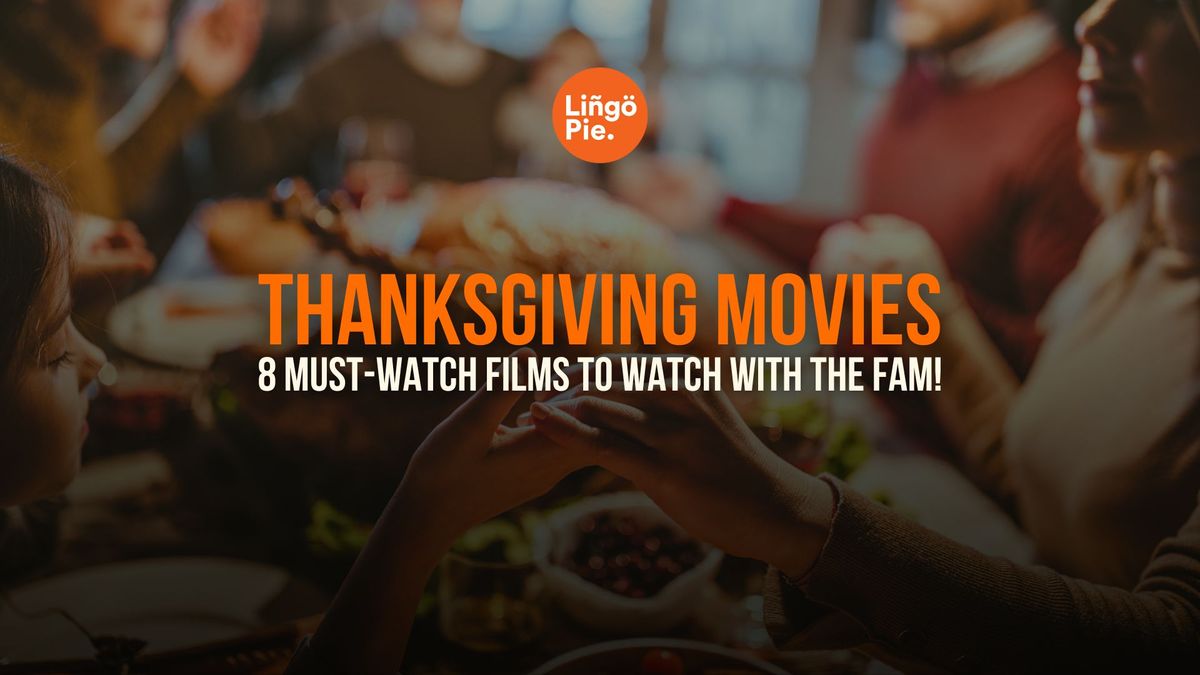Ah, Thanksgiving – that magical time when we stuff ourselves with turkey, dodge awkward family questions, and inevitably end up in a food coma on the couch. But you know what makes those post-feast moments even better? A great movie that everyone can enjoy together!
In this post, we've handpicked 8 perfect Thanksgiving films that'll add an extra sprinkle of joy to your holiday. In the end, we'll also show you how to make the most of your binge-watching sesh and pick up some new language skills while you're at it.
- 10+ Best Rom-Coms On Netflix To Watch With Your Partner
- 10 Comedy Movies Like Despicable Me
- 8 Best Comedy Movies Like Superbad To Watch ASAP

Best Movies to Watch on Thanksgiving
Always Be My Maybe

If you've ever wondered "what if?" about that high school sweetheart who got away, "Always Be My Maybe" is your perfect Thanksgiving treat. Ali Wong stars as Sasha, a celebrity chef whose life takes an unexpected turn when she runs into her childhood crush Marcus (Randall Park) back in San Francisco.
Between the sizzling chemistry, mouth-watering food scenes, and an absolutely legendary Keanu Reeves cameo, this charming rom-com serves up the perfect blend of laughs and heart – ideal for your post-turkey viewing pleasure.
Instant Family
Looking for a heartwarming film that'll make you laugh, cry, and hug your family members a little tighter? "Instant Family" hits all the right notes. Mark Wahlberg and Rose Byrne star as Pete and Ellie, a couple whose journey into fostering leads them to unexpectedly welcome not one, but three kids into their home.
What follows is a beautifully messy, incredibly real, and often hilarious look at what happens when your family doubles in size overnight. With its perfect balance of humor and heart, this movie reminds us that sometimes the best families are the ones we never saw coming – making it an ideal choice for your Thanksgiving gathering.
Tower Heist

Think Ocean's Eleven meets Working Class Heroes, and you've got "Tower Heist" – a wildly entertaining caper that's perfect for post-turkey viewing. Ben Stiller leads an all-star cast as Josh Kovaks, a building manager who decides it's time for some creative payback when a wealthy Wall Street resident (Alan Alda) scams his entire staff out of their life savings.
Teaming up with a street-smart thief played by Eddie Murphy at his comedic best, Josh cooks up the ultimate revenge plan: a high-stakes heist in the heart of Manhattan. With its perfect mix of laughs, thrills, and satisfying justice, this is the kind of movie that'll keep everyone awake – even after that third helping of stuffing.
The Blind Side
Sandra Bullock delivers an Oscar-winning performance in this movie as Leigh Anne Tuohy, a strong-willed Southern mom who opens her home and heart to Michael Oher (Quinton Aaron), a homeless teen with untapped potential both on and off the football field. What unfolds is an incredibly moving story about the life-changing impact of giving someone a chance and the true meaning of family.
With bits of humor, heart, and inspiring moments, this film captures the essence of what Thanksgiving is all about: gratitude, generosity, and the families we choose.
Fatherhood

What makes this film special isn't just its raw honesty about the messy, sometimes overwhelming journey of single parenthood, but the beautiful moments of joy and discovery sprinkled throughout. With powerful performances from Hart and veteran actress Alfre Woodard, this touching story reminds us that sometimes the strongest families are built through adversity – making it a perfect Thanksgiving watch that will have you reaching for both the tissues and your loved ones.
Holidate
Ever wished you had a plus-one just to shut down those dreaded "Why are you still single?" holiday interrogations? That's exactly what leads Sloane (Emma Roberts) and Jackson (Luke Bracey) to strike up their genius "holidate" arrangement – being each other's go-to plus-one for every holiday celebration, no strings attached. Of course, as any rom-com fan can guess, keeping things strictly platonic through Christmas, Valentine's Day, St. Patrick's Day, and yes, Thanksgiving, proves trickier than expected.
With its perfect mix of holiday chaos, awkward family dynamics, and undeniable chemistry between the leads, "Holidate" is the perfect lighthearted escape when you need a break from those real-life holiday dinner table questions about your love life.
A Family Thanksgiving

Ever wonder what your life would be like if you'd taken a completely different path? "A Family Thanksgiving" serves up this delicious what-if scenario when workaholic lawyer Claudia gets an unexpected reality check that turns her perfectly ordered world upside down. Through a magical twist of fate, this career-obsessed attorney finds herself transported to an alternate life where instead of court cases and client meetings, she's juggling family dinners and soccer practices.
You know why we love this? Well, it delivers a reminder that sometimes the best things in life can't be measured in billable hours. Perfect for anyone who needs a gentle nudge to put down their phone and really appreciate the family gathered around their Thanksgiving table.
Friendsgiving
If your Thanksgiving celebrations tend to be more chosen family than blood relatives, "Friendsgiving" will feel like a hilarious home video of your own life. When best friends Molly and Abbey decide to host what's supposed to be a "simple" Thanksgiving dinner for their inner circle, chaos ensues in the most relatable way possible.
If you ask us, this comedy perfectly captures the beautiful mess that happens when friends become family – and reminds us why sometimes the best holiday memories come from the most imperfect moments.

Why Movies are a Thanksgiving Must-Have
You see, movies are perfect for that tricky pre-dinner period when early guests arrive and you're still busy in the kitchen. Put on something light to keep kids entertained and give arriving adults a natural place to gather. It beats having everyone hover around the kitchen asking when dinner will be ready!
Then there's the post-feast sweet spot – that golden hour when everyone's too full to move but not quite ready for dessert. This is prime movie time. Instead of forcing conversation when everyone's in a food coma, a good film gives the family a chance to relax together while actually digesting. Plus, it prevents that awkward exodus where half your guests try to sneak off for a nap!
Our most convincing reason? Watching movies solves the "how long should we stay?" dilemma. A film gives your gathering a natural endpoint, helping guests transition smoothly between dinner and departure without any awkwardness. It's the perfect way to wind down the evening while still spending quality time together.
Turn Movie Time into Language Learning Time!
While these Thanksgiving movies are great in English, why not take your holiday entertainment to the next level by exploring films in other languages?
With Lingopie, you can transform your cozy post-turkey movie sessions into an engaging language-learning experience. Imagine watching a heartwarming Italian TV shows with dual subtitles, picking up authentic Spanish phrases from a modern rom-com, or understanding Korean drama without relying entirely on subtitles.
The best part? Your brain is actually more receptive to language learning when you're relaxed and entertained – making that post-feast movie time the perfect learning opportunity.

Lingopie makes this experience seamless with features like interactive subtitles, instant word translations, and the ability to create personalized flashcards from movie dialogue. Plus, you'll pick up authentic slang, cultural nuances, and real-world expressions that you'd never find in a textbook.
So this Thanksgiving, why not start a new tradition? Gather your family, grab those leftovers, and dive into a world of cinema that'll expand your horizons while you unwind.





![5 Non-Traditional Christmas Gifts For Language Learners [2024]](/blog/content/images/2024/11/Non-Traditional-Christmas-Gifts-For-Language-Learners-.jpg)


![7 International Films Debuting At Tribeca Film Festival [2025]](/blog/content/images/size/w300/2025/06/tribeca-film-festival.jpg)

